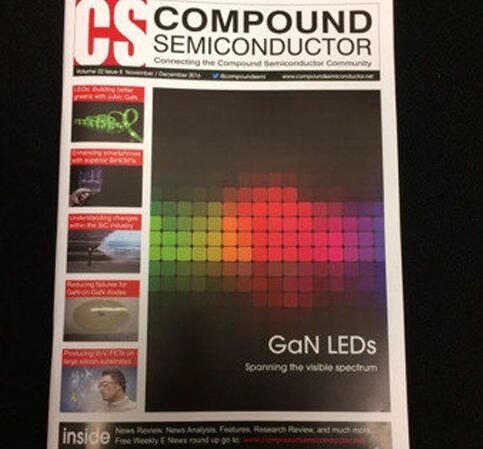The latest issue of the optoelectronic industry's authoritative magazine "Compound Semiconductor" introduced the world's first single-crystal full-color LED, and used the invention as the cover story of the publication to describe in detail the future of this technology for the next generation of lighting. And the significant impact that the display may have, even called "agame-changer for next-generation lighting" (agame-changer for next-generation lighting), the inventor is two scholars from Taiwan.

Figure 1: Chen Zhijia (left) and Ye Yachuan, the inventor of the world's first single crystal full-color light-emitting diode
Since the invention of high-brightness blue and green light-emitting diodes (LEDs) by Japanese scientist Nakamura Shuji (2014 Nobel Laureate in Physics and current UC professor) more than 20 years ago, LEDs have been widely used in everyday lighting, mobile phones and televisions. Backlights, cars and medical equipment.
However, there are only monochrome LEDs on the market. In full-color or white-light applications that require blue, green and red (three primary colors), only three monochromatic LEDs can be used to make a full-color LED or blend in a blue LED. Add a yellow phosphor to achieve a white-like effect.
These methods are difficult to manufacture, high in price, wasteful of electricity, or inefficient. In particular, mobile phones and TVs are increasingly demanding power and resolution, and the traditional methods have encountered bottlenecks.

Figure 2: The cover of the latest issue of the "Compound Semiconductor" journal introduces single crystal full color LEDs
This long-standing problem has been solved by Chinese scientists. Ostendo EpiLab., an Ostendo TechInc., Southern California, developed the world's first full-color LED. They used GaN materials to develop three special quantum structures that emit three different colors of light that can be emitted independently or in combination.
Due to the power-saving and long-life characteristics of LEDs, full-LED displays made of full-color LEDs will likely replace the currently used liquid crystal technology (LCD) and even surpass organic light-emitting diodes (OLEDs).
Dr. Chen Zhijia, the host of the project, said that using blue or green LEDs made of GaN is a mature technology, but it is very difficult to make red LEDs. They are not only the few teams in the world that can achieve this goal. It is the only one that can concentrate the three primary colors on a small device, and can use any one of them at will. If the circuit is properly matched, it can mix a variety of colors and the picture quality will be more beautiful.
The two inventors are Chen Zhijia and Ye Yachuan from Taiwan, China.
Chen Zhijia graduated from the Department of Electronic Physics of the Taiwan Jiaotong University in China. He received his Ph.D. in Electrical Engineering from the State University of New York. He was an associate professor in the Department of Electrical Engineering at the University of Maryland. He is currently the head of the Ostendo Epitaxial Laboratory.
Ye Yachuan graduated from the Electrical Engineering Department of the National Taiwan University of China and obtained a Ph.D. in Electrical Engineering from Los Angeles. He has served as a researcher at the Jet Propulsion Laboratory (NASA-JPL) of Tecstar and NASA and is currently the chief scientist of the company.

Wall-hung Boiler Pressure Sensor
Boiler Water Pressure Sensor,Wall Hung Boiler Pressure Sensor,Water Pressure Transducer,Water Leak Sensor
Shenzhen Ever-smart Sensor Technology Co., LTD , https://www.fluhandy.com